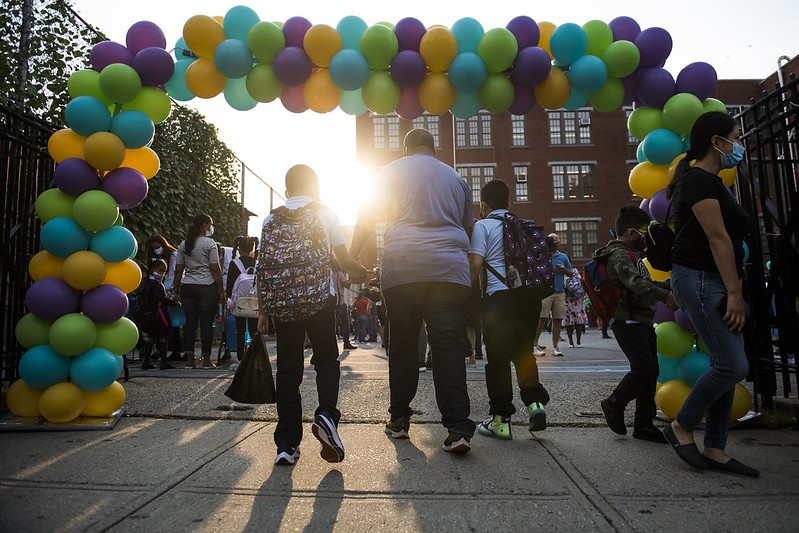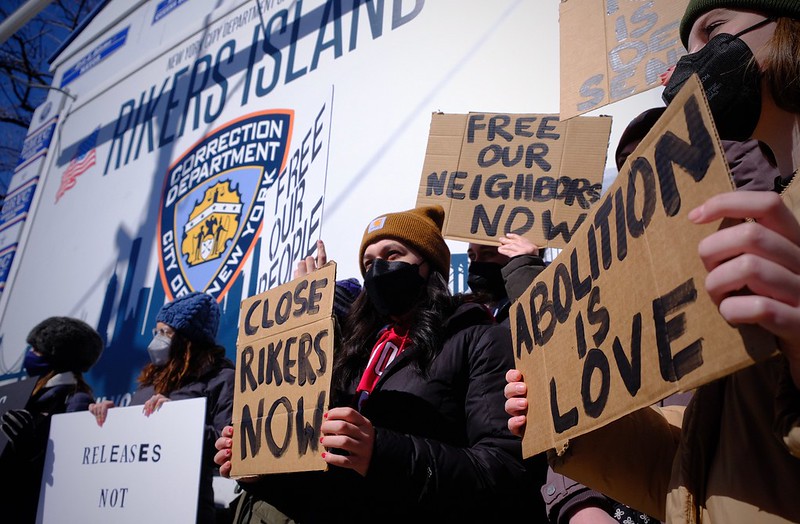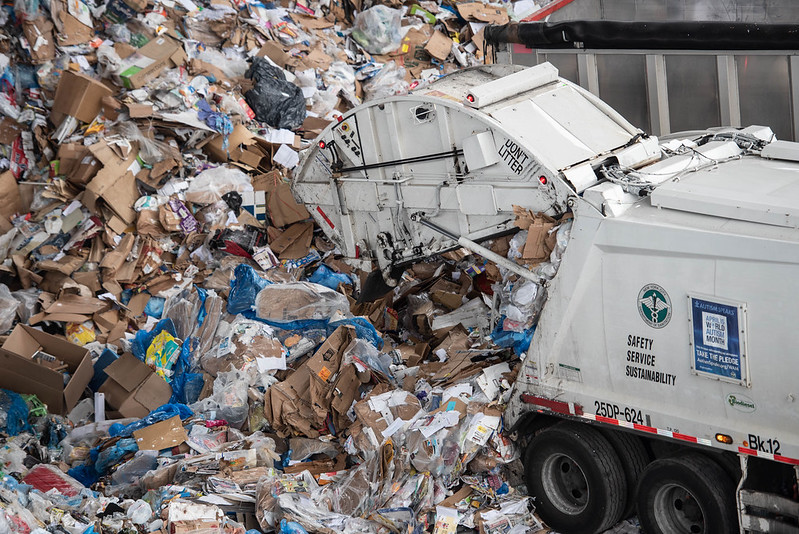To Boost the City's Recovery, Get ‘Learning Leaders’ Back in School

Parents back to school (photo: Ed Reed/Mayoral Photography)
Two non-profit organizations I led later closed down, for very different reasons. One, the September 11th Fund, closed in 2004, having allocated all its funds and determining that many other organizations were in place to continue to provide funding and services to victims of 9/11. This was the right, though difficult thing to do, and it probably should happen more often.
But sometimes a non-profit is forced to close despite the fact that it is doing unique, valuable, impactful work. This is what happened to another organization I led, Learning Leaders, which shut down five years ago this month.
The oldest, largest public school parent volunteer organization in the country, it was tragic that it had to cease operating because it couldn’t come up with the support needed to sustain its work. Now more than ever we need parents in the schools helping kids catch up on reading, math, and social-emotional skills after the long, stressful time spent out of the classroom due to COVID-19. The new Mayor and Schools Chancellor should take the lead in bringing Learning Leaders back to our schools as quickly as possible.
Founded in 1956 as the NYC School Volunteer Program, Learning Leaders grew steadily from a small core of stay-at-home moms in Manhattan into a city-wide corps of trained parents volunteering to work with students on their academic skills with the full support and cooperation of the city’s principals and teachers.
At its highest point, there were approximately 15,000 Learning Leaders volunteers, the vast majority of whom were parents volunteering in their own kids’ schools, in all boroughs, across all income levels and ethnic groups.
I was the Executive Director of Learning Leaders from 1998-2002 (I initiated the change of name to more adequately reflect the role – and deserved pride – of the parent volunteers). Before I left for the September 11th Fund, we contracted with a respected research organization, Arete Corporation, to evaluate the impact of Learning Leaders on the schools in which it worked and on the academic performance of the volunteers’ own kids.
The research went far beyond the anecdotal and subjective; it included a telephone survey of a random sample of 2,000+ parent volunteers as well as the academic records (provided with Department of Education and parental consent) of 7,000+ children of volunteers and a similar sized blind sample of records of other children in the same schools. The conclusions of its report, “Parent Volunteers Make the Difference” were unequivocal:
“The overwhelming conclusion… is that the Learning Leaders approach “works.” It is a major factor in bringing about positive change in parental behaviors, student performance and the quality of school environments. It has demonstrable impact on higher student academic performance, a more orderly school atmosphere…., and better parent-teacher communication…It is not simply volunteering itself but, more specifically, volunteering as Learning Leaders that leads to these benefits to public schools, parents and their children.”
The Arete report documents a number of benefits of the Learning Leaders program including more time spent by parents on homework and reading with their children, better school attendance and scores in reading and math, and lower suspension rates in schools with large corps of parent volunteers.
Learning Leaders was a win for everyone – students, schools, parents. Roughly 95% of the parents surveyed said they were very positive about their experience; 4% said somewhat positive. There was not a single negative response. Many parent volunteers were motivated to continue their own education and/or become employees in the schools. This was not a pilot program; almost 300,000 students were engaged each year. Why on earth would such a popular and vital program be allowed to close down?
The answer is a combination of factors. It was difficult to recruit new board members and other individual supporters willing to make significant financial commitments to local public education. Foundations, which had been generous and important supporters of LL eventually moved on to other priorities. The de Blasio administration, for reasons I do not completely understand, did not regard Learning Leaders as a priority and declined to solicit or allocate private funding for it through the Mayor’s Fund to Advance New York City or to increase its relatively small ($400,000) allocation from the Department of Education.
So the board reluctantly and sadly decided to terminate operations, use its remaining funds to provide severance to the staff and turn its training materials over to NY Cares in the hopes that it would use them to develop a new school volunteer program. (NY Cares has volunteer programs in a certain schools in the Bronx and Queens but no plan to expand to a city-side effort.)
There can be no disagreement that bringing our public schools back fully and strongly is crucial to the city’s recovery and children’s future. We need all hands on deck. Parent involvement is often favorably cited but Learning Leaders was far more than a platitude. It was a real force for educational achievement and could be readily expanded even more if given support and encouragement.
Mayor Adams and Chancellor Banks, read the Arete Report and find a way to bring back Learning Leaders! Its entire budget was less than $3 million a year; this level of combined private and public funding can be found if you make it a priority.
***
Carol Kellermann was president of Citizens Budget Commission from 2008 through 2018.
***
Have an op-ed idea or submission for Gotham Gazette? Email This email address is being protected from spambots. You need JavaScript enabled to view it.
Solving The Crisis of Rikers Now and In The Future

Outside Rikers Island jails (photo: Gerardo Romo/NYC Council Media Unit)
Rikers Island is a devastatingly terrible investment. New York City spends more on jails than anywhere else in the country – over $500,000 per person per year. Yet, violence rates dwarf those elsewhere.
The jails on Rikers Island are decrepit beyond repair. Their crumbling walls are turned into weapons. Built mostly on decaying landfill, the jails are plagued by methane leaks and asbestos. Working conditions for staff, and morale, are abysmal. Almost everyone hurt by Rikers is Black or Latino – staff and incarcerated people, families, and communities, because what happens in Rikers does not stay in Rikers.
Ending this maelstrom of dysfunction and danger requires immediate action on two fronts: pressing forward with the borough jails necessary to close Rikers forever, and safely lowering the jail population to a level the Department of Correction (DOC) can handle. Both will pay profound dividends, saving lives and dollars.
To put it bluntly, without rebuilt borough jails, we simply cannot close Rikers.
Closer to courts, family, and services, the borough jails will speed up the administration of justice and put people on a far better path to re-entry. State-of-the-art design will ensure staff have safer working environments. The jails also make financial sense.
Borough jails will cost $575 million per year to build, paid for with bonds. Compare that to the $2.6 billion per year the city spends to run DOC today. The safer, more efficient facilities can slash those operating costs by almost $2 billion.
The jails will be bolstered by hundreds of new secure hospital beds for people with serious mental and physical illnesses. All are on pace to be completed by the legal deadline to close Rikers: August 31, 2027.
Still, new jail construction can be reduced if the city secures the three empty or underused state prisons in Manhattan and converts them to secure, therapeutic facilities for women and people with serious mental illness.
Some say we should rebuild on Rikers. Such a scheme would cost up to 15% more than the borough-based jail plan and take years longer to finish. Demolition and site remediation alone on the former garbage dump would cost billions. Having to work around an active jail complex would severely limit construction hours and access. New jails on Rikers would also completely fail to address the isolation that allowed lawlessness and lack of accountability to fester for decades.
Even as we work toward a new structural and operational future, we must lower the number of people locked up in Rikers, safely and smartly.
Start with supportive housing. An estimated 2,500 people with serious mental illness and addiction issues cycle in and out of Rikers at a cost of $500,000 per year per person, in deplorable conditions. A supportive housing bed (affordable housing plus wrap-around services) costs $42,000 per year per resident, and provides stability and safety.
Then focus on the almost 90% of people at Rikers who are held pre-trial. About 1,500 of them have been in jail over one year waiting for their day in court. Incarceration of those people alone has cost city taxpayers at least $750 million.
The city should follow the lead of other parts of the U.S. and establish Population Review Teams that can comb through case by case to determine whether people in Rikers can be safely released with conditions like electronic monitoring and mandatory treatment, or whether their cases can be resolved fairly. Fewer people will languish in Rikers for years. Fewer victims will wait endlessly to know if the person accused of harming them is actually guilty, and if so, will be held accountable.
Finally, DOC is overstretched and underskilled. An independent federal monitor reports that on any given day, over 30% of the workforce is not coming to work and/or is not available to work with incarcerated individuals, with dire consequences. Herman Diaz died this month at Rikers after choking on an orange, in part because no staff member was at the assigned post inside his housing unit.
DOC must close the most dangerous jails on Rikers and consolidate people into fewer facilities, covid-permitting. Violence would drop. Work conditions and morale would improve. Not to mention, we would save millions. The city should use some of that money for strong leadership training for Rikers supervisors, and mental health support for staff who frequently experience trauma in the jails.
These concrete steps will ensure we can close Rikers Island forever, while helping prevent crime and lower recidivism. They will also improve conditions significantly for anyone who remains incarcerated and for correctional staff. That’s the kind of investment we need.
***
Zachary Katznelson is Executive Director of the Independent Commission on New York City Criminal Justice and Incarceration Reform.
***
Have an op-ed idea or submission for Gotham Gazette? Email This email address is being protected from spambots. You need JavaScript enabled to view it.
For the Earth, It's Essential New York Leaders Pass Extended Producer Responsibility

Trash (photo: Michael Appleton/Mayoral Photography Office)
New Yorkers buy and order a lot of stuff. And all of that stuff comes in packaging, all too much of it plastic. So much stuff that of the 17 million tons of waste generated annually in New York State, 40% comes from product packaging and paper products – plastic containers, glass bottles, aluminum cans, cardboard, and other materials.
Across the United States, only 50% of PPP is recycled; in New York State, the rate of recycling for PPP hasn’t changed in nearly 20 years. And while the financial and physical responsibility to properly dispose of and recycle these products falls on and has been growing for local governments and taxpayers, there has not been a meaningful reduction in the amount of waste that goes to the landfill.
That’s why we must shift our waste system that heavily relies on reactive measures to one that takes a proactive approach to materials management.
Extended Producer Responsibility (EPR) shifts the responsibility of the post-consumer stage of a product back to the producer. It provides environmental benefits by boosting recycling rates; building the market for post-recycled content — building a true circular economy — and providing community benefits by alleviating the burden of recycling for municipalities, allowing them to invest more resources back into the community.
New York loses around 860,000 tons of potentially recyclable materials every year, the equivalent of only 20% of people utilizing recycling programs. However, in regions where extended producer responsibility has been instituted, that number has jumped to 70%, driven by ease of access.
Earlier this year, Governor Hochul included EPR legislation in her executive budget to take the pressure off of municipalities and put it back on producers. A version of this EPR legislation sponsored by State Senator Todd Kaminsky was also included in the Senate’s one-house budget, but not in the Assembly’s.
The proposed Extended Producer Responsibility Act would place the responsibility of dealing with product waste on producers rather than municipalities, who have long been overwhelmed with the scale of waste they have to deal with. If passed, EPR will reimburse local governments for the expenses of collecting and processing recyclables, while requiring producers to pay for the collection and recycling of the packaging materials they distribute into the state. Outside of New York City local governments currently pay $80 million per year to keep recycling programs going.
We all know that before we get to recycling we should reduce and reuse first. Sustainable waste management starts with products that are more durable, less toxic, less resource intensive to make, and, when the end of their useful lifetime finally comes, more recyclable. That’s why successful EPR programs use what are called eco modulation fees to incentivize producers to price in sustainability. This means that regulated entities that produce less total packaging waste, pack their wares in easily reusable packaging, and use higher amounts of post-recycled content pay less into the program, boosting their bottom line.
The EPR proposals being debated as part of the New York state budget would also ban toxic chemicals like PFAS in packaging materials.
EPR is already a familiar concept to New Yorkers — we use it for electronic waste, car tires, and soon, paint and pharmaceutical drugs. While EPR for product packaging and paper products was authorized by a first U.S. state, Maine, last year, it has been used in Canada and the European Union for years.
Now New York has a chance to build on those models and authorize a stronger EPR for packaging in time for Earth Day. Governor Hochul and the State Senate have proposed EPR legislation as part of the budget. Now we need the State Assembly to negotiate this bill as part of the adopted budget due by April 1.
***
Julie Tighe is President of the New York League of Conservation Voters. On Twitter @julietighe17 & @nylcv.
***
Have an op-ed idea or submission for Gotham Gazette? Email This email address is being protected from spambots. You need JavaScript enabled to view it.




